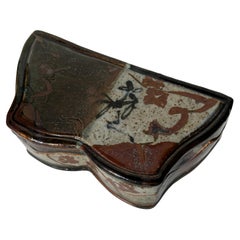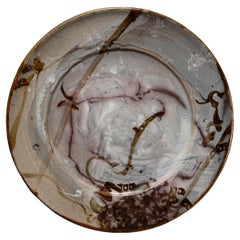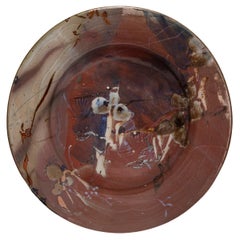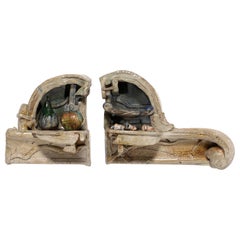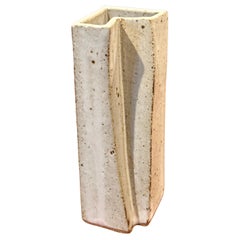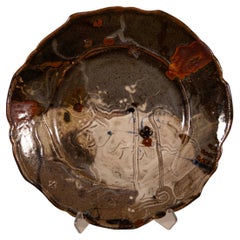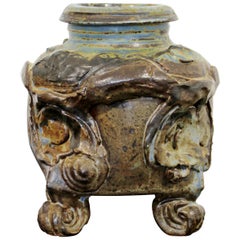John Glick Decorative Objects
to
11
11
2
9
4
1
1
11
1
11
11
11
Height
to
Width
to
11
11
11
11
1,348
731
483
482
Creator: John Glick
John Glick Ceramic Garden Planterette Signed
By John Glick
Located in Bloomfield Hills, MI
The Ceramic Garden Planterette is an example of the kind of work by which John Glick became so famous. He was seduced by the effects of the reduction kiln, which decreased the levels of oxygen during firing, inducing the flame to pull oxygen out of the clay and glazes changing the colors of the glazes depending on their iron and copper content. In this way he achieved the rich gradients of ochre and umber and variations in stippling and opacity. The piece is signed by Glick and stamped with the name of his studio: Plum Street Pottery on the verso.
John was an American Abstract Expressionist ceramicist born in Detroit, MI. Though open to artistic experimentation, Glick was most influenced by the styles and aesthetics of Asian pottery—an inspiration that shows in his use of decorative patterns and glaze choices. He has said that he is attracted to simplicity, as well as complexity: my work continually reflects my re-examination that these two poles can coexist… or not, in a given series. Glick also took influences from master potters of Japan, notably Shoji Hamada and Kanjrio Kawai, blending their gestural embellishments of simple forms with attitudes of Abstract Expressionism. He was particularly drown to the work of Helen Frankenthaler whose soak-stain style resonated with Glick’s multi-layered glaze surfaces, which juxtaposed veils of atmospheric color with gestural marks and pattern. He spent countless hours developing and making his own tools in order to achieve previously unseen results in his work with clay and glaze.
Glick’s “Plum Tree Pottery” (now a designated historic landmark in Farmington Hills, Michigan) studio opened around 1965 and closed in the summer of 2016. It was a private studio space for John and a number of his students and assistants. He believed his shapes evolved guided by forces apparently outside his control. This was instinctual, intellectual and due to his openness to change, fusing into what he thought was the most positive force behind a potter’s approach: evolution and growth. Some have called it inspiration.
John was not only a major figure in the Detroit creative community, but in the ceramics world at large. According to Shelley Selim in her book on John, “John Glick: A Legacy in Clay” John remains: “one of the most recognizable names in the field of studio pottery – known for lecturing, publishing, and offering workshops widely – and his work has been featured in well over a hundred local, national and international exhibitions since he was a college student in the late 1950s.” Along with this John has mentored over thirty studio apprentices over five and a half decades, received numerous grants and awards for his work, and has been prolific, with an estimated 300,000 ceramic wares throughout the world.
He received his Masters from Cranbrook Academy of Art in Bloomfield Hills, Michigan, working with Maija Grotell, a legendary and influential teacher. Grotell was noted for her deep interest in the human connection to nature’s rhythms and patters. These ideas often grounded her dialog with her students including Glick, affecting, a profund and lasting influence on his future work. This famous Art Academy was designed by architect and faculty member, Eliel Saarinen who collaborated with Charles and Ray Eames on chair and furniture design. Numerous creative artists who are alumni of Cranbrook include: Harry Bertoia, Florence Knoll, Jack Lenor Larsen, Donald Lipski, Duane Hanson, Nick Cave, Hani Rashid, George Nelson, Urban Jupena (Nationally recognized fiber artist), Artis Lane (the first African-American artist to have her sculpture, "Sojourner Truth," commissioned for the Emancipation Hall in the Capital Visitor Center in Washington DC), Cory Puhlman (televised Pastry Chef extraordinaire), Thom O’Connor (Lithographs), Paul Evans (Brutalist-inspired sculpted metal furnishings), Eugene Caples (small bronze images/abstract), Morris Brose (Bronze Sculptures), Herb Babcock (blown glass), Larry Butcher (mixed media) and Lauren Anais Hussey...
Category
1990s American American Classical John Glick Decorative Objects
Materials
Ceramic
John Glick pottery/stoneware box , jewelry/ table box, signed .
By John Glick
Located in Los Angeles, CA
Beautiful box with waved design in stoneware / ceramic. Made by Plum Tree Potters, John Glick.
Category
Late 20th Century American Modern John Glick Decorative Objects
Materials
Ceramic
John Glick Plum Street Pottery Ceramic Charger Monumental
By John Glick
Located in Bloomfield Hills, MI
The ceramic charger is an example of the kind of work by which John Glick became so famous. He was seduced by the effects of the reduction kiln, which decreased the levels of oxygen during firing, inducing the flame to pull oxygen out of the clay and glazes changing the colors of the glazes depending on their iron and copper content. In this way he achieved the rich gradients of ochre and umber and variations in stippling and opacity. It is signed by the artist and stamped with Plum Street Pottery #129 on the verso.
John was an American Abstract Expressionist ceramicist born in Detroit, MI. Though open to artistic experimentation, Glick was most influenced by the styles and aesthetics of Asian pottery—an inspiration that shows in his use of decorative patterns and glaze choices. He has said that he is attracted to simplicity, as well as complexity: my work continually reflects my re-examination that these two poles can coexist… or not, in a given series. Glick also took influences from master potters of Japan, notably Shoji Hamada and Kanjrio Kawai, blending their gestural embellishments of simple forms with attitudes of Abstract Expressionism. He was particularly drown to the work of Helen Frankenthaler whose soak-stain style resonated with Glick’s multi-layered glaze surfaces, which juxtaposed veils of atmospheric color with gestural marks and pattern. He spent countless hours developing and making his own tools in order to achieve previously unseen results in his work with clay and glaze.
Glick’s “Plum Tree Pottery” (now a designated historic landmark in Farmington Hills, Michigan) studio opened around 1965 and closed in the summer of 2016. It was a private studio space for John and a number of his students and assistants. He believed his shapes evolved guided by forces apparently outside his control. This was instinctual, intellectual and due to his openness to change, fusing into what he thought was the most positive force behind a potter’s approach: evolution and growth. Some have called it inspiration.
John was not only a major figure in the Detroit creative community, but in the ceramics world at large. According to Shelley Selim in her book on John, “John Glick: A Legacy in Clay” John remains: “one of the most recognizable names in the field of studio pottery – known for lecturing, publishing, and offering workshops widely – and his work has been featured in well over a hundred local, national and international exhibitions since he was a college student in the late 1950s.” Along with this John has mentored over thirty studio apprentices over five and a half decades, received numerous grants and awards for his work, and has been prolific, with an estimated 300,000 ceramic wares throughout the world.
He received his Masters from Cranbrook Academy of Art in Bloomfield Hills, Michigan, working with Maija Grotell, a legendary and influential teacher. Grotell was noted for her deep interest in the human connection to nature’s rhythms and patters. These ideas often grounded her dialog with her students including Glick, affecting, a profund and lasting influence on his future work. This famous Art Academy was designed by architect and faculty member, Eliel Saarinen who collaborated with Charles and Ray Eames on chair and furniture design. Numerous creative artists who are alumni of Cranbrook include: Harry Bertoia, Florence Knoll, Jack Lenor Larsen, Donald Lipski, Duane Hanson, Nick Cave, Hani Rashid, George Nelson, Urban Jupena (Nationally recognized fiber artist), Artis Lane (the first African-American artist to have her sculpture, "Sojourner Truth," commissioned for the Emancipation Hall in the Capital Visitor Center in Washington DC), Cory Puhlman (televised Pastry Chef extraordinaire), Thom O’Connor (Lithographs), Paul Evans (Brutalist-inspired sculpted metal furnishings), Eugene Caples (small bronze images/abstract), Morris Brose (Bronze Sculptures), Herb Babcock (blown glass), Larry Butcher (mixed media) and Lauren Anais Hussey...
Category
1990s American Expressionist John Glick Decorative Objects
Materials
Ceramic
John Glick Plum Street Pottery Ceramic Charger Monumental
By John Glick
Located in Bloomfield Hills, MI
The ceramic charger is an example of the kind of work by which John Glick became so famous. He was seduced by the effects of the reduction kiln, which decreased the levels of oxygen during firing, inducing the flame to pull oxygen out of the clay and glazes changing the colors of the glazes depending on their iron and copper content. In this way he achieved the rich gradients of ochre and umber and variations in stippling and opacity. It is signed by the artist and stamped with Plum Street Pottery on the verso.
John was an American Abstract Expressionist ceramicist born in Detroit, MI. Though open to artistic experimentation, Glick was most influenced by the styles and aesthetics of Asian pottery—an inspiration that shows in his use of decorative patterns and glaze choices. He has said that he is attracted to simplicity, as well as complexity: my work continually reflects my re-examination that these two poles can coexist… or not, in a given series. Glick also took influences from master potters of Japan, notably Shoji Hamada and Kanjrio Kawai, blending their gestural embellishments of simple forms with attitudes of Abstract Expressionism. He was particularly drown to the work of Helen Frankenthaler whose soak-stain style resonated with Glick’s multi-layered glaze surfaces, which juxtaposed veils of atmospheric color with gestural marks and pattern. He spent countless hours developing and making his own tools in order to achieve previously unseen results in his work with clay and glaze.
Glick’s “Plum Tree Pottery” (now a designated historic landmark in Farmington Hills, Michigan) studio opened around 1965 and closed in the summer of 2016. It was a private studio space for John and a number of his students and assistants. He believed his shapes evolved guided by forces apparently outside his control. This was instinctual, intellectual and due to his openness to change, fusing into what he thought was the most positive force behind a potter’s approach: evolution and growth. Some have called it inspiration.
John was not only a major figure in the Detroit creative community, but in the ceramics world at large. According to Shelley Selim in her book on John, “John Glick: A Legacy in Clay” John remains: “one of the most recognizable names in the field of studio pottery – known for lecturing, publishing, and offering workshops widely – and his work has been featured in well over a hundred local, national and international exhibitions since he was a college student in the late 1950s.” Along with this John has mentored over thirty studio apprentices over five and a half decades, received numerous grants and awards for his work, and has been prolific, with an estimated 300,000 ceramic wares throughout the world.
He received his Masters from Cranbrook Academy of Art in Bloomfield Hills, Michigan, working with Maija Grotell, a legendary and influential teacher. Grotell was noted for her deep interest in the human connection to nature’s rhythms and patters. These ideas often grounded her dialog with her students including Glick, affecting, a profund and lasting influence on his future work. This famous Art Academy was designed by architect and faculty member, Eliel Saarinen who collaborated with Charles and Ray Eames on chair and furniture design. Numerous creative artists who are alumni of Cranbrook include: Harry Bertoia, Florence Knoll, Jack Lenor Larsen, Donald Lipski, Duane Hanson, Nick Cave, Hani Rashid, George Nelson, Urban Jupena (Nationally recognized fiber artist), Artis Lane (the first African-American artist to have her sculpture, "Sojourner Truth," commissioned for the Emancipation Hall in the Capital Visitor Center in Washington DC), Cory Puhlman (televised Pastry Chef extraordinaire), Thom O’Connor (Lithographs), Paul Evans (Brutalist-inspired sculpted metal furnishings), Eugene Caples (small bronze images/abstract), Morris Brose (Bronze Sculptures), Herb Babcock (blown glass), Larry Butcher (mixed media) and Lauren Anais Hussey...
Category
1990s American Expressionist John Glick Decorative Objects
Materials
Ceramic
John Glick Modernist Stoneware Glazed Ceramic Footed Planter Plum Tree Pottery
By John Glick
Located in Keego Harbor, MI
A modernist stoneware glazed ceramic planter by Detroit artist John Glick of Plum Tree Pottery. Circa late 20th century. Glazed in earthtones. Artisisnal yet functional and makes a u...
Category
Late 20th Century American John Glick Decorative Objects
Materials
Ceramic
John Glick Plum Tree Pottery "Wall Mantel Series"
By John Glick
Located in Bloomfield Hills, MI
John Glick is well-known for his beautifully rendered functional pieces of art. His decorative pieces, especially his large pots, are breathtakingly powerful objects. Glick's creative genius, however, is most exquisitely shown in this unique grouping of objets d'art. The Wall Hanging has a lovely classical scroll shelf. The objets on the shelf include an apple and pear - both fruits frequently rendered by artists from the Dutch Masters to Cezanne because of their perfectly balanced shape and rich colors. In addition is a small Greek or Roman styled dish used as an oil lamp. The other three objets are mysterious twisted tube-like organic shapes. John Glick, at one of his richest, creative bests. The objets are of various sizes, movable and can be displayed as desired. The size given is the overall size of both pieces and the objets d'art.
John was an American Abstract Expressionist ceramicist born in Detroit, MI. Though open to artistic experimentation, Glick was most influenced by the styles and aesthetics of Asian pottery—an inspiration that shows in his use of decorative patterns and glaze choices. He has said that he is attracted to simplicity, as well as complexity: my work continually reflects my re-examination that these two poles can coexist… or not, in a given series. Glick also took influences from master potters of Japan, notably Shoji Hamada and Kanjrio Kawai, blending their gestural embellishments of simple forms with attitudes of Abstract Expressionism. He was particularly drown to the work of Helen Frankenthaler whose soak-stain style resonated with Glick’s multi-layered glaze surfaces, which juxtaposed veils of atmospheric color with gestural marks and pattern. He spent countless hours developing and making his own tools in order to achieve previously unseen results in his work with clay and glaze.
Glick’s “Plum Tree Pottery” (now a designated historic landmark in Farmington Hills, Michigan) studio opened around 1965 and closed in the summer of 2016. It was a private studio space for John and a number of his students and assistants. He believed his shapes evolved guided by forces apparently outside his control. This was instinctual, intellectual and due to his openness to change, fusing into what he thought was the most positive force behind a potter’s approach: evolution and growth. Some have called it inspiration.
John was not only a major figure in the Detroit creative community, but in the ceramics world at large. According to Shelley Selim in her book on John, “John Glick: A Legacy in Clay” John remains: “one of the most recognizable names in the field of studio pottery – known for lecturing, publishing, and offering workshops widely – and his work has been featured in well over a hundred local, national and international exhibitions since he was a college student in the late 1950s.” Along with this John has mentored over thirty studio apprentices over five and a half decades, received numerous grants and awards for his work, and has been prolific, with an estimated 300,000 ceramic wares throughout the world.
He received his Masters from Cranbrook Academy of Art in Bloomfield Hills, Michigan, working with Maija Grotell, a legendary and influential teacher. Grotell was noted for her deep interest in the human connection to nature’s rhythms and patters. These ideas often grounded her dialog with her students including Glick, affecting, a profund and lasting influence on his future work. This famous Art Academy was designed by architect and faculty member, Eliel Saarinen who collaborated with Charles and Ray Eames on chair and furniture design. Numerous creative artists who are alumni of Cranbrook include: Harry Bertoia, Florence Knoll, Jack Lenor Larsen, Donald Lipski, Duane Hanson, Nick Cave, Hani Rashid, George Nelson, Urban Jupena (Nationally recognized fiber artist), Artis Lane (the first African-American artist to have her sculpture, "Sojourner Truth," commissioned for the Emancipation Hall in the Capital Visitor Center in Washington DC), Cory Puhlman (televised Pastry Chef extraordinaire), Thom O’Connor (Lithographs), Paul Evans (Brutalist-inspired sculpted metal furnishings), Eugene Caples (small bronze images/abstract), Morris Brose (Bronze Sculptures), Herb Babcock (blown glass), Larry Butcher (mixed media) and Lauren Anais Hussey...
Category
Late 20th Century American American Craftsman John Glick Decorative Objects
Materials
Ceramic
John Glick Modernist Stoneware Glazed Ceramic Planter Vessel Plum Tree Pottery
By John Glick
Located in Keego Harbor, MI
A modernist stoneware glazed ceramic planter by Detroit artist John Glick of Plum Tree Pottery. Circa late 20th century. Glazed in earthtones. Artisisnal yet functional and makes a u...
Category
Mid-20th Century American John Glick Decorative Objects
Materials
Ceramic
John Glick Modernist Stoneware Glazed Ceramic Pottery Tea Pot Plum Tree Pottery
By John Glick
Located in Keego Harbor, MI
A modernist stoneware glazed ceramic tea pot by Detroit artist John Glick of Plum Tree Pottery. Circa late 20th century. Glazed in earthtones. Artisisnal yet functional and makes a u...
Category
Mid-20th Century American John Glick Decorative Objects
Materials
Ceramic
John Glick Plum Street Pottery Ceramic Glazed Bowl/Charger Extra-large
By John Glick
Located in Bloomfield Hills, MI
The ceramic bowl is an example of the kind of work by which John Glick became so famous. He was seduced by the effects of the reduction kiln, which decreased the levels of oxygen during firing, inducing the flame to pull oxygen out of the clay and glazes changing the colors of the glazes depending on their iron and copper content. In this way he achieved the rich gradients of ochre and umber and variations in stippling and opacity. It is signed by the artist and stamped with Plum Street Pottery on the verso.
John was an American Abstract Expressionist ceramicist born in Detroit, MI. Though open to artistic experimentation, Glick was most influenced by the styles and aesthetics of Asian pottery—an inspiration that shows in his use of decorative patterns and glaze choices. He has said that he is attracted to simplicity, as well as complexity: my work continually reflects my re-examination that these two poles can coexist… or not, in a given series. Glick also took influences from master potters of Japan, notably Shoji Hamada and Kanjrio Kawai, blending their gestural embellishments of simple forms with attitudes of Abstract Expressionism. He was particularly drown to the work of Helen Frankenthaler whose soak-stain style resonated with Glick’s multi-layered glaze surfaces, which juxtaposed veils of atmospheric color with gestural marks and pattern. He spent countless hours developing and making his own tools in order to achieve previously unseen results in his work with clay and glaze.
Glick’s “Plum Tree Pottery” (now a designated historic landmark in Farmington Hills, Michigan) studio opened around 1965 and closed in the summer of 2016. It was a private studio space for John and a number of his students and assistants. He believed his shapes evolved guided by forces apparently outside his control. This was instinctual, intellectual and due to his openness to change, fusing into what he thought was the most positive force behind a potter’s approach: evolution and growth. Some have called it inspiration.
John was not only a major figure in the Detroit creative community, but in the ceramics world at large. According to Shelley Selim in her book on John, “John Glick: A Legacy in Clay” John remains: “one of the most recognizable names in the field of studio pottery – known for lecturing, publishing, and offering workshops widely – and his work has been featured in well over a hundred local, national and international exhibitions since he was a college student in the late 1950s.” Along with this John has mentored over thirty studio apprentices over five and a half decades, received numerous grants and awards for his work, and has been prolific, with an estimated 300,000 ceramic wares throughout the world.
He received his Masters from Cranbrook Academy of Art in Bloomfield Hills, Michigan, working with Maija Grotell, a legendary and influential teacher. Grotell was noted for her deep interest in the human connection to nature’s rhythms and patters. These ideas often grounded her dialog with her students including Glick, affecting, a profund and lasting influence on his future work. This famous Art Academy was designed by architect and faculty member, Eliel Saarinen who collaborated with Charles and Ray Eames on chair and furniture design. Numerous creative artists who are alumni of Cranbrook include: Harry Bertoia, Florence Knoll, Jack Lenor Larsen, Donald Lipski, Duane Hanson, Nick Cave, Hani Rashid, George Nelson, Urban Jupena (Nationally recognized fiber artist), Artis Lane (the first African-American artist to have her sculpture, "Sojourner Truth," commissioned for the Emancipation Hall in the Capital Visitor Center in Washington DC), Cory Puhlman (televised Pastry Chef extraordinaire), Thom O’Connor (Lithographs), Paul Evans (Brutalist-inspired sculpted metal furnishings), Eugene Caples (small bronze images/abstract), Morris Brose (Bronze Sculptures), Herb Babcock (blown glass), Larry Butcher (mixed media) and Lauren Anais Hussey...
Category
Late 20th Century American John Glick Decorative Objects
Materials
Ceramic
John Glick ceramic /stoneware box / jewelry / table box , signed
By John Glick
Located in Los Angeles, CA
Beautiful box / jewelry / table desk box. made for the well known artist / potter , John Glick , for Plum Tree Potters .
Category
Late 20th Century American Post-Modern John Glick Decorative Objects
Materials
Stoneware
John Glick Plum Street Pottery Signed Monumental Ceramic Charger
By John Glick
Located in Bloomfield Hills, MI
The ceramic charger with scalloped edge is an example of the kind of work by which John Glick became so famous. He was seduced by the effects of the reduction kiln, which decreased the levels of oxygen during firing, inducing the flame to pull oxygen out of the clay and glazes changing the colors of the glazes depending on their iron and copper content. In this way he achieved the rich gradients of ochre and umber and variations in stippling and opacity. It is signed on verso.
John was an American Abstract Expressionist ceramicist born in Detroit, MI. Though open to artistic experimentation, Glick was most influenced by the styles and aesthetics of Asian pottery—an inspiration that shows in his use of decorative patterns and glaze choices. He has said that he is attracted to simplicity, as well as complexity: my work continually reflects my re-examination that these two poles can coexist… or not, in a given series. Glick also took influences from master potters of Japan, notably Shoji Hamada and Kanjrio Kawai, blending their gestural embellishments of simple forms with attitudes of Abstract Expressionism. He was particularly drown to the work of Helen Frankenthaler whose soak-stain style resonated with Glick’s multi-layered glaze surfaces, which juxtaposed veils of atmospheric color with gestural marks and pattern. He spent countless hours developing and making his own tools in order to achieve previously unseen results in his work with clay and glaze.
Glick’s “Plum Tree Pottery” (now a designated historic landmark in Farmington Hills, Michigan) studio opened around 1965 and closed in the summer of 2016. It was a private studio space for John and a number of his students and assistants. He believed his shapes evolved guided by forces apparently outside his control. This was instinctual, intellectual and due to his openness to change, fusing into what he thought was the most positive force behind a potter’s approach: evolution and growth. Some have called it inspiration.
John was not only a major figure in the Detroit creative community, but in the ceramics world at large. According to Shelley Selim in her book on John, “John Glick: A Legacy in Clay” John remains: “one of the most recognizable names in the field of studio pottery – known for lecturing, publishing, and offering workshops widely – and his work has been featured in well over a hundred local, national and international exhibitions since he was a college student in the late 1950s.” Along with this John has mentored over thirty studio apprentices over five and a half decades, received numerous grants and awards for his work, and has been prolific, with an estimated 300,000 ceramic wares throughout the world.
He received his Masters from Cranbrook Academy of Art in Bloomfield Hills, Michigan, working with Maija Grotell, a legendary and influential teacher. Grotell was noted for her deep interest in the human connection to nature’s rhythms and patters. These ideas often grounded her dialog with her students including Glick, affecting, a profund and lasting influence on his future work. This famous Art Academy was designed by architect and faculty member, Eliel Saarinen who collaborated with Charles and Ray Eames on chair and furniture design. Numerous creative artists who are alumni of Cranbrook include: Harry Bertoia, Florence Knoll, Jack Lenor Larsen, Donald Lipski, Duane Hanson, Nick Cave, Hani Rashid, George Nelson, Urban Jupena (Nationally recognized fiber artist), Artis Lane (the first African-American artist to have her sculpture, "Sojourner Truth," commissioned for the Emancipation Hall in the Capital Visitor Center in Washington DC), Cory Puhlman (televised Pastry Chef extraordinaire), Thom O’Connor (Lithographs), Paul Evans (Brutalist-inspired sculpted metal furnishings), Eugene Caples (small bronze images/abstract), Morris Brose (Bronze Sculptures), Herb Babcock (blown glass), Larry Butcher (mixed media) and Lauren Anais Hussey...
Category
1990s American Expressionist John Glick Decorative Objects
Materials
Ceramic
Related Items
Modernist Studio Pottery Stoneware Vase - Signed
Located in San Diego, CA
A very nice MCM California studio pottery stoneware vase, circa 1970s. The vessel is in very good vintage condition with no chips or cracks and measures 3"W x 3"D x 6.75"H. Signed o...
Category
Mid-20th Century American Mid-Century Modern John Glick Decorative Objects
Materials
Stoneware
Signed Sara Sax Rookwood Pottery Lidded Rectangular Box
By Rookwood Pottery Co., Sara Sax
Located in Cincinnati, OH
This gorgeous ceramic lidded rectangular box was made by Rookwood Pottery of Cincinnati, Ohio, and decorated by renowned artist, Sara Sax. Rookwood has long been recognized as one of...
Category
1920s American Arts and Crafts Vintage John Glick Decorative Objects
Materials
Ceramic
Architectural Pottery "Tire Planter" by John Follis in Matte Red Glaze
By Architectural Pottery
Located in Los Angeles, CA
Architectural Pottery small "Tire"' planter designed by John Follis in matte red glaze. The planter shows patina consistent with use and age. Structurally sound with minor glaze loss...
Category
Mid-20th Century American Mid-Century Modern John Glick Decorative Objects
Materials
Ceramic
Abstract Tree Brown Ceramic Freeform circa 1970 Stoneware Pottery La Borne
Located in Neuilly-en- sancerre, FR
Abstract ceramic form with brown pottery glaze, circa 1970.
Elegant colors.
Realized in La Borne.
Excellent original condition.
Dimension: 16 x 14 x 5 cm.
Category
1970s French Mid-Century Modern Vintage John Glick Decorative Objects
Materials
Ceramic
$887
H 6.3 in W 5.52 in D 1.97 in
Antiqu Salmon Red Concrete Garden Urn Planter
Located in Topeka, KS
Awesome antique concrete garden urn or planter. This salmon colored paint encrusted urn is in fabulous vintage condition with lots of gorge...
Category
20th Century American American Classical John Glick Decorative Objects
Materials
Concrete
Monumental Mid-20th Century American Studio Pottery Bowl
Located in Chicago, IL
A monumental-scale mid-20th century American studio hand-thrown glazed ceramic bowl with fantastic texture and earthy neutral glaze colors. Signed illegibly on the bottom.
Category
1970s American Mid-Century Modern Vintage John Glick Decorative Objects
Materials
Ceramic
Malachite Jewelry Box
Located in New York, NY
A very beautiful and substantial green Malachite decorative or jewelry box, circa late-20th century. This green Malachite box has a hexagon shape with a white onyx marble star with gold gilt detail on top lid. A great decorative piece or jewelry box (as demonstrated), to hold necklaces, rings, earring, cufflinks, etc., on a vanity, nightstand, dresser, desk, credenza, walk-in-closet, etc. Very good condition as shown in images. No chips noted. Dimensions: 3.38" Depth x 4" Width.
Purple charoite box shown also available, search 1stDibs ref. #: LU1314228491742
Green malachite box with cameo, search ref. #: LU1314228492012 (SOLD)
Small gold and malachite turtle...
Category
Late 20th Century Modern John Glick Decorative Objects
Materials
Malachite, Onyx
Ceramic Vase, Glazed Stoneware Vase, Ciboure Pottery, France, circa 1925
By Ciboure
Located in New York, NY
One of a set of beautiful ceramics from Ciboure Pottery, this piece is inspired by antiquity—evident in its form, its spare coloring, and its depiction of classical figures. Executed...
Category
Early 20th Century French Art Deco John Glick Decorative Objects
Materials
Stoneware
Artisan Rosewood Jewelry Box
By Wharton Esherick
Located in Philadelphia, PA
Beautifully made Rosewood Jewelry Box. 2 Triangular Lids open to reveal a velvet lined interior. Carved handle makes it easy to access interio...
Category
1980s American Modern Vintage John Glick Decorative Objects
Materials
Rosewood
Bitossi Vase, Ceramic, Blue, White, Signed
By Bitossi
Located in New York, NY
Bitossi vase, ceramic blue and white, signed. Small scale slab sided vase with three color glaze. Signed with paper label on the underside: CB 7/21 Made in Italy.
Category
1960s Italian Mid-Century Modern Vintage John Glick Decorative Objects
Materials
Ceramic
Jewelry Box French
Located in New York, NY
An antique French brass ormolu and velvet jewelry box, Rococo design style, circa late-19th century, France. Box is perforated brass ormolu (ormolu has a design of urns, leaves and f...
Category
Late 19th Century French Rococo Antique John Glick Decorative Objects
Materials
Brass, Ormolu
Bronze Tree Midcentury Garden Wall Sculpture
Located in Essex, MA
Natural bronze tree midcentury 1950s garden wall sculpture measuring 48 inches high by 39 inches wide by 1.25 inches in depth. Lifelike tree form sculpture of tree...
Category
1920s American Vintage John Glick Decorative Objects
Materials
Bronze
Previously Available Items
John Glick Plum Tree Charger Plate Pottery Mid Century Modern
By John Glick
Located in Keego Harbor, MI
Discover this captivating Mid Century Modern Plum Tree Charger Plate by the renowned potter John Glick. This artistic ceramic plate is a conve...
Category
Mid-20th Century Unknown Mid-Century Modern John Glick Decorative Objects
Materials
Ceramic
Mid-Century Modern John Glick Signed Handmade Pottery Ceramic Footed Vase 1960s
By John Glick
Located in Keego Harbor, MI
For your consideration is a gorgeous, handmade, ceramic, footed art vase, signed on the bottom by John Glick, circa 1960s. In excellent condition. The dimensions are 6" diameter x 7"...
Category
1960s American Mid-Century Modern Vintage John Glick Decorative Objects
Materials
Ceramic
Mid-Century Modern John Glick Signed Handmade Pottery Ceramic Art Box, 1960s
By John Glick
Located in Keego Harbor, MI
For your consideration is a stunning, handmade, ceramic art box, signed on the bottom by John Glick, circa 1960s. In excellent condition. The dimension...
Category
1960s American Mid-Century Modern Vintage John Glick Decorative Objects
Materials
Ceramic
John Glick decorative objects for sale on 1stDibs.
John Glick decorative objects are available for sale on 1stDibs. These distinctive items are frequently made of ceramic and are designed with extraordinary care. Many of the original decorative objects by John Glick were created in the neoclassical style in united states during the late 20th century. Prices for John Glick decorative objects can differ depending upon size, time period and other attributes — on 1stDibs, these items begin at $1,250 and can go as high as $5,200, while a piece like these, on average, fetch $2,940.

